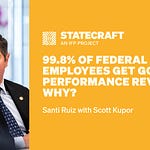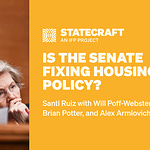At the Abundance Conference a few weeks ago, today’s guests joined me on a panel to discuss “How Bureaucracy is Breaking Government.” They were so insightful that I invited them back to re-record the conversation for Statecraft.
Brief intros: Nicholas Bagley was General Counsel to Governor Gretchen Whitmer. He wrote an article called The Procedure Fetish about the problems with the procedures we’ve created for federal agencies.
Kathy Stack served almost three decades at the Office of Management and Budget (OMB). Since then, she has spent her time thinking about how better use of data can improve federal and state social programs.
Jenny Mattingley also served at the OMB, focusing on hiring reform and workforce efforts. She was also the founding director of the White House Leadership Development Program.
We discussed:
Why isn’t the Paperwork Reduction Act doing its job?
Why is there no constituency for government effectiveness?
How difficult is it to create a new form?
How have the right and the left collaborated to strengthen judicial review?
This transcript has been lightly edited for clarity.
What do members of Congress, executives on Wall Street, and UN Ambassadors all have in common? They read Principals, a non-partisan, analytical, and free political newsletter by Semafor. Each morning, Semafor Principals delivers distilled glimpses into the corridors of power in Washington and beyond. Join thousands of leaders on the Hill who rely on Principals to kick off their day —subscribe for free.
How would you describe the problem you’re trying to solve?
Bagley: Lawyers have a lot of well-intentioned concerns about the way that government agencies function. But we process those concerns by layering more and more procedural rules on agencies so they will do what we care about. We have lost track of ensuring government agencies can operate effectively.
Stack: My focus is strengthening the capacity of state and local governments to use federal funds effectively. Over a trillion dollars in federal grants go out annually. Hundreds of overlapping federal programs and state and local governments are stymied by layers of administrative requirements, outdated rules, and misconceptions about what they're allowed to do. We need a way of cleaning that up.
Mattingley: I look at how you make federal agencies work better, both for constituents and for federal employees, because there are a lot of out-of-date policies and laws. A lot of myth and procedure could be peeled back. How do we get people to take a step back and streamline them?
I think all of you have something to say about the Paperwork Reduction Act.
Stack: The Paperwork Reduction Act was seen as a way of reducing burden by coordinating across programs, making sure that they collected the information that was required and nothing else. But it’s become a transactional OMB review process, where each program is left on its own to figure out what data comes into OMB. Reviewing this is, frankly, a fairly low priority for OMB, because the Office of Information and Regulatory Affairs [OIRA, nestled within OMB] that now oversees the PRA was also given responsibility in the ‘80s for regulatory review, which always takes priority.
Do you have an example of the Paperwork Reduction Act in practice?
Mattingley: This is one of my favorite issues where laws from the ‘70s haven't changed to catch up with how business is done these days. The PRA says that you can't ask the same question of more than 10 people.
Just to clarify, the requirement is that an agency can't ask more than 10 American citizens the same question?
[NB: After we recorded this interview, OIRA published new guidance that encourages agencies to conduct usability testing. It states that agencies are no longer bound by this requirement.]
Otherwise, it triggers this whole review process, which can take months or years. In the ‘80s, the idea was that agencies were constantly asking people to fill out 20-page forms. Mailing out forms was a cost to the government and there was a cost to the person filling it out and mailing it back. So the goal was not to overburden people with 20 agencies asking the same question with the same forms.
Fast forward to today where everything is web-based: you're not mailing forms, and people are used to filling out quick surveys. The law doesn’t make sense anymore. If the Veterans Affairs Department is putting up a form for veterans to sign up for a service, they can either go through the process of posting what they want to do in the Federal Register and taking six or eight months for review with OIRA. Or they can go out to veterans and say “Can you fill this form out? Does it work for you? Do you understand the questions?” and then start tweaking. I think most citizens would assume that’s how things happen. But this is why we see things take so long to change or don’t account for user feedback. They’re built without customer input.
[See how Marina Nitze tackled this issue at the Veterans Affairs Department in a previous Statecraft interview.]
Kathy, how did you encounter these procedural barriers at the Office of Management and Budget, or OMB?
Stack: The OMB creates government-wide policies that affect how state and local governments are allowed to use their funds. OMB has something called Uniform Grants Guidance, which sets documentation requirements for the finance and performance reporting that state and local governments must use.
Every grant program has to report back to OMB, and there is a Paperwork Reduction Act requirement that requires all of those reporting instruments to come through OMB for clearance. These are implemented by different parts of OMB, but OMB lacks a good sense of how they interact at the local level.
And there are tons of OMB requirements. Even when they're rescinded or replaced, the view on the outside is that these are still requirements. OMB does not have a feedback loop to understand how much time public servants are spending on things that are not required, but that people assume is either an OMB or a statutory requirement.
OMB also does not have an off switch. New administrations come in with new policy officials. They want new programs and regulations to address a particular high-profile problem. A small staff at OMB is amazing at marshaling resources to solve that problem. The solution is usually a new layer of policy or process. There is rarely a request from the White House to look at what is getting in the way of accomplishing policies or being more effective about implementing longstanding laws.
Bagley: If you work at OMB and you see these paperwork requests, part of your day job is helping agencies make those better. And so if you're asked, “Does the Paperwork Reduction Act do good?” From your perspective, you've helped people make their requests better. It looks like the PRA is working. What you never see is all the time and effort that's wasted getting your approval, and all the costs it imposes on actually getting user feedback. So some of the staunchest adherents to some of the stupidest procedural rules are the very agencies that are implementing them.
If you talk to folks at OIRA, they will tell you the Paperwork Reduction Act is a really important part of their job. “It's really important that we have a lever here.” What's never asked is, ”What kind of harm are you trying to guard against? And is it worth the candle?” Because gosh, the costs are acute and the benefits are what? Some improvements on the questions you ask on a few forms from the Social Security Administration? Really? Is that worth all the time and wasted effort from agencies? Can't we trust them to do their jobs well enough that we don't need to create this bottleneck on basic user feedback?
We're talking about problems that ought to be relatively straightforward to solve. OMB and the agencies are all part of the executive branch, they can get on the phone and call each other.
Imagine how magnified these problems are when challenges to agency actions get routed through the judiciary. You've got generalist judges who don't know the first thing about agency operations or the domain, but who weigh in with wide-ranging review authority and tell agencies how to do their jobs. It's the problem we see with the Paperwork Reduction Act, but on steroids.
Can you walk me through this Paperwork Reduction Act process?
Let's say I'm at Veterans Affairs and I'm trying to roll out a new program that involves forms. What interactions do I have with OMB or other agencies?
Bagley: The first stop is not to go to OMB, it's to get the form crafted within the agency. Agencies are big and complicated and often require lots of different units to weigh in. Only after you've worked through the internal bottlenecks do you get to turn to OMB.
Mattingley: It could be the privacy officer, depending on what type of information you're going to collect. It's often the Office of General Counsel, so you have to get the agency lawyers to sign off.
Often, folks trying to do customer experience or user feedback get blocked by their own agencies. They're not even making it up to the OIRA review because their agency has said ”We're going to hit the Paperwork Reduction Act, we can't ask those questions.”
There are ways to get exceptions or blanket approval, but it never gets to that point because agencies think there's a regulatory blocker, so they don't even go there. Again, it's a myth that's built up. So part of it is OIRA. Part of it is this significant burden in the agencies.
Stack: There are also missed opportunities with the PRA. Agencies are looking through their own lens at what information they need to collect in a program to meet statutory and regulatory requirements. But they can't see the high-value data that's being collected by a sister program or a different department. In theory, the on-paper goal of the Paperwork Reduction Act is for OMB to help people understand what data is already being collected that could be reused.
Another missed opportunity is definitions and data standards. Each program is on its own to set up its own collection instruments. They're not looking across to see that 20 different programs are using the same term with a different meaning. Or where they could be using standard metrics that would incentivize state and local governments to set up more integrated data systems and analytics capacity.
We've got a lot of people on hamster wheels collecting data for compliance purposes to meet reporting requirements that were set sometimes decades ago. They keep pushing data up to the federal government. It's not useful to the grantees or the federal agencies, and it’s certainly not reducing administrative burden.
What's a concrete example where someone is collecting data and it turns out that three or four other programs are doing the same thing?
Stack: I have an example, but OIRA and the Paperwork Reduction Act had nothing to do with it. President Obama was focused on getting unscrupulous higher education institutions out of the student loan program, because they were saddling kids with debt and not training them for good jobs.
He needed to figure out, what were those bad schools? My part of OMB worked with the Education Department, the Treasury, and the IRS to take information collected by the IRS and use that to pre-populate the FAFSA form [Free Application for Federal Student Aid]. This made completing the FAFSA simpler, reducing one burden. It also allowed us to link student loan and student aid information from Education with IRS data, so that we could see the earnings outcomes of kids going through these programs.
So it was a win-win: prepopulating the FAFSA form reduced the time burden on the people who fill it out. And by getting those agencies working together, we found a way to measure earnings outcomes that enabled the Department of Education to weed out the bad schools.
OIRA did not play a real role in that, but it happened in part because the center of government, OMB, was able to see the connections and bring the right players together.
Bagley: Kathy’s example is an example of highly effective management, but just notice it had nothing to do with legalistic compliance with procedural rules. I think we're too apt to think that if you just make a law, agencies are going to perform better. But if you've got a badly-performing agency, you need to think about resource constraints, management, information flow: a whole list of genuine problems that have nothing to do with compliance with legalistic rules.
Nick, in The Procedure Fetish, you mentioned the Paperwork Reduction Act is one of many well-intentioned procedural burdens on agencies. Where else does a well-intentioned idea stop an agency from being effective?
Bagley: You can imagine asking, in your darkest moments, what are the bad things an agency might do? As soon as you conjure one of these terrible stories, you can usually point to a law Congress has adopted to force the agency to do better. You might be worried that agencies are going to hide things from the public. So we have the Freedom of Information Act. You might be afraid that members of an advisory committee are meeting outside the public meeting rooms. So there's the Federal Advisory Committees Act. You might be worried that agencies are going to make bad decisions. So you subject their decisions to hard-look review in the courts, which requires the courts to walk through their justifications and invalidate the agency action if it's found wanting.
None of these are bad goals. We want agencies to be transparent and accountable, make good decisions, and think about the environment. But the rules are strikingly inattentive to the way they make agencies defensive, slow, sclerotic, hidebound, and legalistic — instead of serving the collective goals that we've set.
I often hear conservatives describe federal regulation as a one-way ratchet. As the government gets bigger, regulation accretes over time.
It sounds like you’re saying procedural burdens on agencies function that way too.
Bagley: Absolutely. It's a one-way ratchet. In its recent changes to administrative law, the Supreme Court doubled down on this highly legalistic, procedural approach to governance. When businesses complain about government red tape, those concerns are taken seriously, although they don’t always lead to action. But concerns that government is too bogged down by procedural rules aren’t taken very seriously. We seem content to impose ever greater regulatory burdens on government officials at the expense of them doing their jobs effectively.
Why is the ratchet one way? Why is it easier to craft, say, the Paperwork Reduction Act than it is to tweak it later?
Bagley: One reason is that these laws create constituencies that thrive on them. Environmental organizations use the National Environmental Policy Act (NEPA) to object to projects that they dislike. Because they depend on NEPA, they will vigorously fight efforts to limit its reach, even if NEPA is making it harder to build the renewable facilities we need to bring online to combat climate change. It’s an important part of how they exercise power. They are not going to let it go without a fight.
Another big problem is there is rarely an organized constituency pushing to relieve burdens on government agencies. Who is affected by the Paperwork Reduction Act? It's the veteran who has a crappy web interface. It's the Medicaid beneficiary who can't figure out how to get benefits. It's the entities that are trying to communicate with these big, sprawling bureaucracies. The bureaucracies can't speak to them to get feedback to improve their operations. In that context, who's going to muscle a reform law through Congress? No one cares enough, even if it's a problem that affects us all quite acutely in the aggregate.
Mattingley: There's also a myth that builds up within federal agencies about what the policy is. Agencies layer policies on top of the law or the OMB policy as a way to avoid getting in trouble for something.
There's this risk aversion, so they set processes that are not actually required by the law. Systems are created because somebody along the way thought it was necessary to protect the agency.
20 years later, nobody questions why these policies were put in place, and no one has the mandate to go through and scale them back. Agencies are following policies written in the ‘70s and ‘80s. They still talk about faxing forms as a requirement because it’s no one’s job to say, “How do we go back through everything and make it simpler?”
This is a question I asked in the panel a few weeks ago, and it still bothers me, so I want to ask it again. You’ve all talked about how there's not a natural constituency for solving some of these problems: the harms are diffuse and the benefits are concentrated.
But why aren't presidents more motivated to fix this problem for themselves? Why is there not a natural equilibrium, where this stuff gets periodically solved by new administrations?
Bagley: Presidents have a lot of priorities. Mucking about in procedural rules that are going to have a generalized effect on their ability to carry out their mission isn't their primary focus. Sometimes strong leadership from the top really can make a difference.
At the state level, some of the permitting reform efforts have made progress at this. It’s not impossible. But presidents care more about achieving substantive success in a narrow set of issues than about making it possible for Fish and Wildlife Services to move a little quicker, or for the Forest Service to be able to come up with forest remediation plans quicker.
Those just aren't going to rise to the White House. The constituencies that maintain the current set of procedural rules are left more or less undisturbed.
Stack: In my experience at OMB, most presidents come in and staff the White House policy councils with a lot of congressional staffers. If they've come from the Hill, they're the people they know. It’s just the inside-Washington view: you want to have people working for you who have those relationships and can move legislation. But these appointees have never worked in federal agencies at a level where they've understood the impact of these procedural constraints. Legislation is often developed with a complete blind spot on all of these administrative procedures.
Mattingley: When we've talked to folks in Congress to get them interested in procedural issues, it’s not what their constituents care about. So that's not what they're going to spend their limited time doing. A president has 4,000 political appointments. They stay for only about two years.
It's not quick to do the type of policy review and de-layering that we're talking about. And heads of agencies are turning over in a much quicker timeframe. It just makes it really tough to build that natural constituency.
I do think some organizations care a lot about it. We need the environmental or health care or land use groups to understand how they touch government and why government working better is important to what they want to do. That's a long-term, heavy lift. But we can start to change the conversation by building understanding intentionally. Just telling people user feedback doesn't get collected and it should be, for example.
The one exception during my career, a president who really cared about implementation issues, was George W. Bush. He was an MBA. He'd been a governor. He brought a lot of people from the Texas government who had been closer to the ground and understood implementation issues. He brought the different parts of OMB together by essentially forcing OMB to develop what they call The President's Management Agenda. That required the budget side of OMB which worked on new programs to work with the management side and develop a set of implementation initiatives that held Cabinet agencies accountable for assessing their effectiveness and figuring out improvement plans.
They took on some of these issues, like the security clearance process for new hires. But these fixes take a long time. It takes real patience from the top to say we're going to invest in things where the payoff may not happen for four or six years.
Kathy, you flagged Bush Jr. as the best president in your professional career on these management issues. Nick, you worked for Governor Gretchen Whitmer.
Is a governor with executive experience better positioned to tackle these problems than somebody from the legislative branch?
Bagley: Without question. Governors have a mandate to address the bread-and-butter issues of their constituents. And, importantly, a lot of governors are trying to get elected in purplish states. The governor’s big issues were “fixing the damn roads,” bringing jobs to Michigan, preventing folk from leaving the state by creating high-quality career paths here. Once you start to say, ”How do we get a new semiconductor facility to locate here in Michigan? What are the kind of levers we have to pull?” The answer is by pushing through the bureaucracy. Then you see that it’s the same thing for the roads. As soon as you see that, you say, “Wait a minute. I've got to start making choices and reorienting my administration to avoid the stumbling blocks.”
Stack: I've been looking at examples of state and local governments that have committed to harnessing all the data they collect in their programs and building integrated data systems with analytics and evaluators figuring out how to get more with less? How do we get better outcomes, create efficiencies, identify improper payments, target resources where they're going to have their biggest impact?
What’s notable is that red-state governors are the pioneers. They come into office with a business approach and ask, “How could you operate these programs if you can't see across the silos?” Indiana, Ohio, and Arkansas are great examples. Other states, including Governor Walz in Minnesota, Rhode Island, and North Carolina are looking to these red states and saying, “How can we do more of that? They're running into a lot of misconceptions about federal restrictions and prohibitions on combining funding or sharing data, but it's the red state governors who cleared the path and said, “You can do this.” But it's not coming from the federal government. The federal government is not sending signals that we want this capacity to be built. The federal government is still quite siloed on this.
Nick, you wrote about how, in the ‘70s and ‘80s, imposing procedures on agencies was a goal of the left. In my lifetime, imposing procedures on agencies has been a goal of the right. How did that change?
Bagley: The highly legalistic governance is really our inheritance from that particular era. In the 1960s, there were a lot of government actors doing bad things in connection with the Civil Rights movement. There were revolts over planners driving highways right through downtowns.
There were oil spills off Santa Barbara, the Cuyahoga River caught fire, and reckless development was ruining wilderness. There was a real sense of a high-handed government that wasn't taking people’s views seriously. Shifts in the zeitgeist, combined with left-wing judges, mainly on the D.C. Circuit, but then endorsed by the Supreme Court, said, “You know what? We're going to think about our job differently. We're not just going to let government do what it thinks best. We're going to ‘ride herd’ on government officials to make sure they're behaving in enlightened ways.”
At the time they were correcting for genuine excesses. But when they did, the left effectively capitulated on its normal distrust of unaccountable black-robed officials of the courts and said, “We want the judiciary to be more involved.” The right saw that and said, ”We do too. We are also concerned about government overreach, albeit of a different kind. We think we can use expanded judicial procedures to advance our ends.”
This marriage between left and right left very little space for anyone to object to the new consensus: that we ought to involve the courts very heavily in government decision-making, and that we ought to channel our disputes through the judiciary, that adherence to procedural rules should be the measure of whether an agency is behaving appropriately.
We've stuck with that ever since the 1970s, even as the world has changed, and even as that approach looks very poorly matched to today's concerns. We desperately need to build new infrastructure, housing, solar facilities, and interstate transmission lines. We seem to be unable to do it because we've committed ourselves to a “Just say no” approach to governance.
Kathy and Jenny, in your work on good governance, do you see a partisan split?
For a long time, only a few folks cared about government management issues, particularly on the Hill. We see more interest now. Some of it takes on partisan tones, but a lot of what we work on is about customer experience, and the idea of getting user feedback and doing human-centered design is very bipartisan. Leveraging AI to make agencies more effective is similarly bipartisan.
When you talk about government reform writ large, that's just too big and unwieldy for people. I think the challenge is breaking it down into different parts: customer experience, AI, certain issue areas.
If we could focus on two or three priorities instead of ten, you could get a lot of people behind that, especially if there were quick wins to show that progress can be made.
One of the most lauded Biden administration initiatives by both sides has been work at the FTC to reduce bureaucratic burden for citizens, like making it easier to cancel subscriptions. People who don’t otherwise follow this stuff seem to love it.
Mattingley: I love the do not call list because I don't like my cell phone getting spam calls. You can focus on the management issues under the umbrella of things that will make people feel better off.
My last big burning question is about government effectiveness, which is a contested concept. What we want the federal government to be effective at is a political question.
When we first ran this panel, there was a sharp question from someone in the audience. He suggested that, if you wanted bipartisan buy-in on government effectiveness, you should be telling agencies to stop doing things outside of their core competencies. For example, the Biden administration shouldn't try to advance its racial goals in the Department of Defense by requiring federal contractors to meet certain diversity requirements.
Nick, what do you think of that argument? Is there a trade-off between building a base for more effective governance, and trying to achieve all the president's priorities?
Bagley: Just because agencies do things you don't like doesn't mean you should double down on finicky procedural rules to make them finally stop.
There is an idea that if we relent on these procedural strictures, agencies are going to continue doing things we don't like. Both sides of the aisle can see agencies doing things they dislike when the other guy is in power. So we're all scared about relinquishing the tools that we have to push back. On the right, they're scared about relinquishing the tools they have to push back on Biden, DEI initiatives. On the left, they’re scared about relinquishing their tools to push back on an ascendant Trump presidency. And I just want to say, we have elections for a reason. The winner should be allowed to follow through on their commitments.
If you think that what they're doing is bad and wrong and ineffective, vote the bums out. But trying to do this through the courts and additional procedural rules hasn't worked. We have to find a different way.
We have to remember that democracies are not about finding a way for us all to agree. Democracies are a way for us to manage disagreement, to channel that disagreement in productive ways. And I think we need to get back to the fundamental premise that sometimes elections have consequences.
You’re talking about agencies doing things that we like or don't like when the other guy is in power. But there's this broader debate in American democracy about how to keep the executive branch from violating the civil rights of American citizens, protecting Bill of Rights protections. One way we keep the executive branch from violating those rights is through judicial review. You're a critic of the overuse of judicial review.
Some might argue that if we stop letting judges review agency action, there's no check on agencies’ ability to violate the civil rights of American citizens. What would you say to that argument?
If you've ever worked at an agency, the last thing you think is, “Man, I am unconstrained today.” There are political and financial and personnel constraints. People in federal agencies are not looking for excuses to trample on civil rights. They are just trying to do their jobs.
Concerns about civil rights were much more acute and salient in the 1960s and the 1970s. Having a firm judicial hand was really important. But we should ask about the tradeoffs today when those kinds of violations are less common, and where the costs of insisting on their protection to the utmost seem so acute.
I haven't seen a lot of evidence that the courts are doing a whole lot to uphold civil rights relative to baseline. I see a lot of evidence that they're making it hard for the government to take steps that would help people across the income and racial spectrum.
Stack: My experience is that tight budgets can be your best friend when it comes to a wake-up call, like “Oh, s***, we’re going to have to tighten our belt by five, ten, twenty percent. How are we using our resources? How much of our staff time is being spent on meaningless processes that are undermining our goals?” If there's no longer hundreds of billions of dollars raining down for a pandemic, people have to rethink what they're going to do and it's a good time to clean up a lot of the red tape.
There's a sense we're going into a more constrained fiscal environment than we have been over the last 10 years. Does that mean we should expect to see agencies hacking away at some of this procedural deadweight?
Stack: I think it's a great opportunity for OMB, as the center of government, to set up accelerated, robust processes to ask agencies where they're not getting value from the effort they're putting in and how they could use technology to achieve the original goals of the Paperwork Reduction Act.
Similarly, OMB should ask state and local governments to bring in their stories, and give them permission to be even bolder.
Nick, you mentioned that federal civil servants are constrained in all kinds of ways. But that doesn’t necessarily mean they reduce constraints on American citizens, right? There are plenty of recent cases, like Loper Bright, where fiscal or other constraints on an agency push the agency to outsource some of its burden to citizens, in unlawful ways. In some of these cases, judicial review is what protects those citizens from federal overreach.
[In Loper Bright Enterprises v. Raimondo, fishing companies sued a federal regulator for passing along the cost of monitors on boats to the fishing companies. The Supreme Court ruled that the regulator overstepped its authority, and the Court overturned the principle of Chevron deference, a decision which may lead to more judicial review of agency decisions.]
I can imagine that in some cases, if an agency has fewer resources and less time, it’s more likely to say, “Let’s make this complicated regulatory question an issue for the subjects of the regulation, and they can try and sort it out or they can deal with the consequences.” So the constraints on the agency push it to create more burden for citizens.
I think it's contingent and hard to know exactly how that plays out. If you’re an agency that’s constrained, you might find it hard to meet people where they are if you don’t have the time, the energy, the attention, or the political will to undo some of the constraints that currently bind folks on the ground.
A very effective agency can be effective at imposing new regulations, it's true. But a very effective agency can also be pretty good at getting rid of old regulations. The right has tended to think, “Let's make it so hard for agencies to operate that they'll mostly just give up, stop, or do less.” What we've seen is that agencies don’t do less when they're getting beat up in the courts: instead, they do what they do worse.
There was this idea that if we could get government smaller, you’d get rid of all these constraints. But the fact is, we're not getting rid of permitting or rules governing the environment, or consumer welfare, or labor. So I'd like folks on the right and the left to think, “How can we make government work better?” Sometimes that will entail overreach and sometimes it will reduce burdens.
Mattingley: Agencies are huge. We're looking at entities that would be complex businesses in the private sector. And we have not invested in “mission support”: many of the IT systems are from the ‘80s.
We don't have the investment in HR systems to make sure we get the right people. To actually clean things up and lessen burden, we’ve got to make sure we make agencies run from a management perspective. So if I could wave a wand, I’d have political appointees come in saying, “I am leading a huge, complex organization. I need to focus on HR, IT, and internal processes.”
We're recording this before the presidential election, but it’ll come out afterward. What are the two or three things that you would agree should be on the new president’s agenda?
Bagley: We've seen bipartisan bills on permitting reform. It’s extremely important for the transition to renewables and for progress more generally. I'd like to see a renewed focus on that.
Stack: I would like to see the OMB establish a senior office charged with understanding the implementation issues that state and local governments face in trying to optimize the hundreds of programs and the trillion dollars they get every year in grants. That feedback loop could really accelerate cleaning up of red tape, so that the dollars are much more focused on outcomes.
Mattingley My agenda item is the internal focus at agencies. If the incoming administration could challenge each person who's coming in to lead agencies to ask employees which processes are working, and which are outdated: you’d hear how the Paperwork Reduction Act piece and other things are constraining employees. Then you could start detangling those so you can detangle them for the American public.













